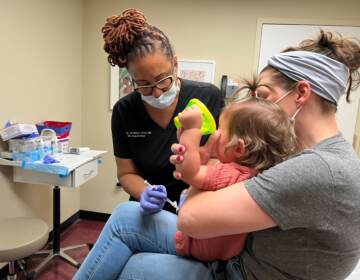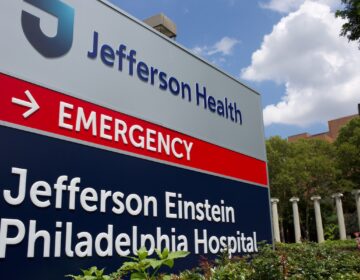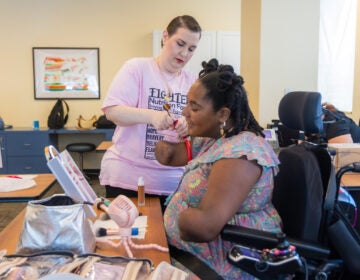How Jefferson Health went from $78M in the red to turning a profit
The Jefferson Health enterprise — which includes 18 hospitals, a university and a health insurance company — transformed its financial situation in the past year.
Listen 1:11
Jefferson Health, which includes Thomas Jefferson University and Jefferson Hospital, turned itself around financially in the past year. (Kristen Mosbrucker-Garza/WHYY)
From Philly and the Pa. suburbs to South Jersey and Delaware, what would you like WHYY News to cover? Let us know!
Jefferson Health’s financial performance has dramatically improved over the past year.
As the second largest employer in the region – soon to become the largest – the overall enterprise employs 42,000 people across the Philadelphia metro area.
It’s not the only profitable health system in the region, nor the only one that has sustained losses in recent years. But the massive swing in its viability as a business does make it stand out.
Jefferson Health generated a $1.3 million in profit for the year ending June 30, compared to a $78.5 million loss in June 2023, according to financial documents shared with bondholders in August. That profit margin is compared to $9.9 billion in total revenue for fiscal year 2024.
Those results are also a significant improvement from $125.8 million in the red for the fiscal year ending June 2022.
Jefferson Health’s financial transformation was the result of several factors, including corporate restructuring, targeted efforts to reduce costs while maintaining patient care standards and leadership decisions that encouraged accountability in every discipline, officials told WHYY News in a recent interview.
Since August 2022, Dr. Joseph Cacchione has served as the CEO of Jefferson Health, which includes Thomas Jefferson University, the hospital network and health insurance business.
Chief Financial Officer John Mordach, who joined in February 2023, credits Cacchione’s vision for the dramatic shift, the board of directors’ support for any structural changes and the “entire village” of employees for its ultimate success.
But it’s been a ‘bumpy ride’ for the health care system’s financial performance since the COVID-19 pandemic began in March 2020, which has been the case worldwide, Mordach said.
“We do have to run ourselves, as if though, we are just like a business,” Mordach said about the nonprofit umbrella organization. “No margin, no mission.”
While the COVID-19 pandemic began roughly five years ago, its influence on the economy and patient decisions has lingered.
“Folks weighing whether they come in or not [for elective procedures],” Mordach said.
What patients decide to do really matters – net patient service revenue accounted for $6.3 billion of that $9.9 billion in revenue at Jefferson Health in fiscal year 2024.
Nationwide, patients are increasingly returning to hospital systems for these non-emergency surgeries and other outpatient care, according to a healthcare utilization tracker created by The Kaiser Family Foundation, now known as KFF.
For example, during the second quarter of 2020, health care services spending by patients contracted by 6.6% compared to second quarter 2019. While there’s been peaks and valleys since then, health care utilization has mostly increased, the KFF tracker shows.
The financial struggles over the past four years at Jefferson Health were attributed to COVID-19 trends, Mordach, the financial executive said.
“A lot of choppiness on volume and access with COVID,” he said.
Since then, there’s been strong demand for outpatient surgery between 2023 and 2024 — about a 3% increase.
“Our physician visits are up almost 4%, so our top line volume [is] strong,” he said. “The university had good strong enrollment, [the] health plan [business] was strong.”
This financial data includes the performance across 18 hospitals, a university and a health insurance company. So on paper, Jefferson Health is really an overarching ‘holding company,’ which refers to all of its individual businesses under the system.
But in practice, Mordach said leadership promotes an active management style.
“We’re not a holding company. We’re really an operating company and our CEO really demonstrates that, and encourages that we’re not sitting around,” he said. “We get out to all our locations and make sure we see what’s going on and listen to our teams.”
To make such sweeping changes, the CEO created an executive team responsible for their area of expertise, which included financial accountability. There were 30 different operational initiatives that each had an ‘executive sponsor,’ from clinical to academic to the insurance health plan.
“Every one had an executive leader or two assigned, with the hope that we could see additional benefits whether its revenue or expenses,” Mordach said.
For example, patients aren’t spending any extra time in hospital beds if there’s no medical reason, which reduces the length of hospital stays.
“That efficiency of that length of stay is tremendous where you don’t have to add any more staff. And on top of that, we’re able to reduce contract labor,” he said. “We did a tremendous job of improving the clinical teams. It allows us to use that bed a little quicker. We’re able to see more patients using the same beds and it really helps a lot.”
Outside contract labor costs were slashed by 50% between fiscal years ending June 2023 and 2024. Jefferson Health spent $63 million less on temporary staffing in fiscal year 2024.
Instead of hiring nurses from an outside agency, there’s now an internal system that offers existing employees incentive pay to volunteer for more shifts.
“It’s an internal agency team and we rotate people across all of our hospitals and clinics if they want to pick up shifts and they get a bit more premium pay but it’s a lot less than what we pay for someone from the outside,” he said. “It also improves quality, because it’s your people. They know where the supplies are, they know the physicians, they know our routines.”
All of these strategic moves that Jefferson Health did are common among ‘high performing hospitals,’ according to hospital management consultant Kaufman Hall.
Higher outpatient revenue, aka patients getting same-day procedures and not staying overnight, reducing contract labor and length of stay reductions.
Jefferson Health also did conduct layoffs – about 400 people last year. But that was not the first decision.
“We took that very seriously and to try and minimize that impact on our employees,” Mordach said.
And now the organization is embarking on its next long-term financial plan, which is meant to look ahead about seven years into the future – such as its planned merger with Lehigh Valley Health Network.
So how can any other hospital system achieve better financial results?
It’s about being selective about any proposed changes, making sure it’s targeted and tracked, Mordach said.
Essentially, a few dozen well-executed plans are better than hundreds of small cuts for short-term gain.
“There’s always a sort of tendency to try and make some immediate moves that in the long-run may not serve your institution or help meaningfully on a recurring [financial] basis,” he said. “Less is more.”

Get daily updates from WHYY News!
WHYY is your source for fact-based, in-depth journalism and information. As a nonprofit organization, we rely on financial support from readers like you. Please give today.







